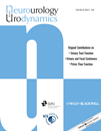Evaluation of demographic, clinical characteristics, and genetic polymorphism as risk factors for pelvic organ prolapse in brazilian women†‡§¶
Heinz Koelbl led the review process.
Conflicts of interest: none.
Contribution to Authorship: Karina de Falco Martins: collected all data and performed the experiments. Andrea Moura Rodrigues Maciel da Fonseca: wrote the manuscript. Ismael Dale Cotrim Guerreiro da Silva: chief of the laboratory where the experimentals were done. Assistence in how to do the experimentals. Conceived and designed the experiments. Rodrigo Aquino Castro: statistical analysis and reviewed the manuscript. Zsuzsanna Jarmy Di Bella: statistical analysis, reviewed the manuscript and the correspondence author. Manoel João Batista Castello Girão: chief of the department of gynecology of the federal university of São Paulo, oriented the research. Marair Gracio Ferreira Sartori: chief of the urogynecology section of the federal university of São Paulo, oriented the research and reviewed the manuscript.
Details of Ethics Approval: The Research and Ethics Committee of the Federal University of São Paulo approved the study protocol. Date: 07/04/2006 Number:0228/06.
Abstract
Objective
Verify the association between genital prolapse, other risk factors and a polymorphism in exon 31 of the collagen III-a1 gene (COL3A1).
Setting
The etiology of genital prolapse is multifactorial, and genetic defects have been proposed. Also, there is evidence that changes in collagen may be responsible for defects in pelvic floor support. The exon 31 polymorphism results in structural changes in the triple helical of the collagen and appears to lead to abnormal synthesis of type III collagen.
Design
Basic science study.
Population
The studied group consisted of 107 patients with stage III and IV genital prolapse (POP-Q). The control group included 209 women with stage 0 and I prolapse.
Methods
After extracting genomic DNA from the peripheral blood, the exon 31 COL3A1 polymorphism was typed by restriction fragment length polymorphism analysis.
Main outcome measures
Association between genital prolapse and exon 31 COL3A1 polymorphism.
Results
No statistically significant differences in genotype and allele frequencies were found between cases and controls (P = 0.75 and 0.66, respectively). Multiple logistic regression analyses identified age (OR = 1.05; 95%CI = 1.01–1.10), BMI (OR = 1.09; 95%CI = 1.01–1.17), presence of at least one vaginal delivery (OR = 7.22; 95%CI = 1.84–28.27), positive family history of POP (OR = 2.27; 95%CI = 1.05–4.93) and a macrosomic foetus (OR = 2.91; 95%CI = 1.24–6.79) as independent risk factors for genital prolapse. In contrast, the number of caesarean deliveries was found to be an independent protective factor (OR = 0.43; 95%CI = 0.24–0.78).
Conclusions
The type III collagen exon 31 polymorphism is not a risk factor for pelvic genital prolapse in this sample. Neurourol. Urodynam. 30:1325–1328, 2011. © 2011 Wiley-Liss, Inc.




